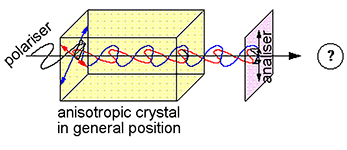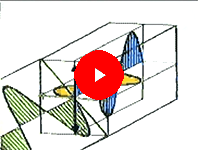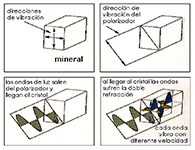


Interference colour. How is it formed?
5 polariser + anisotropic mineral (general case) + analyser
5.1 What happens when a crystal is placed between the nicols?
General case (general cut and general position)
When a polarised light wave arrives at an anisotropic crystal in a general position (neither in the specific isotropic position nor coinciding with the directions of vibration of the nicols, already considered in previous screens), it experiences double refraction. The initial incident wave splits into two polarised waves which vibrate in perpendicular planes and which, for simplicity's sake, we will imagine to be moving with the same direction of propagation, as indicated in the figure 1 and the video.
In ideal, simplistic terms, for each direction of incidence of light on the crystal, the crystal's atoms vibrate in only two directions, which are perpendicular to each other.
When the light ray arrives at the crystal, the wave stimulates the crystal's atoms and because it cannot vibrate in the direction in which it arrives (PP´), it divides into two waves which vibrate according to the two possible planes of vibration (XX´and YY´ in figure 2).
Moreover, the particles of the crystal do not vibrate with the same facility in the two directions permitted, thus leading to a fast component (corresponding to a low refractive index) and a slow component (high refractive index). There will therefore be a phase difference, or retardation, between the waves which are vibrating in perpendicular planes inside the crystal. The more anisotropic the mineral, the greater the phase difference.
But what happens when these two waves arrive at the analyser with a phase difference?
Index | Introduction | PPL | XPL ortos | Interf colour | Int. c. formed? | Previous | Next